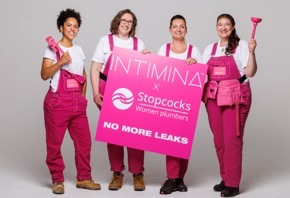INTIMINA x Stopcocks partner to provide an innovative customer service for women to tackle the taboo around pelvic floor leaks
- Innovative partnership follows research revealing 11.7 million UK women* experience bladder leaks at least once a week
- Women’s intimate health brand INTIMINA has teamed up with Stopcocks, the world’s only national company of women plumbers to launch ‘No More Leaks’
- The ‘No More Leaks’ campaign aims to start open and honest conversations around pelvic floor leaks, with Stopcocks plumbers providing their customers with advice, guidance and even tools for prevention during World Continence Week
- To learn more about your pelvic floor and leak prevention click here
If you’ve got a leak, a plumber is probably the best person to call… unless any unwanted ‘drips’ were actually due to an intimate health issue with your pelvic floor, that is… Until now.
Women’s intimate health brand INTIMINA has partnered with Stopcocks, the UK’s only national company of women plumbers to tackle the taboo about leaks of a different kind during World Continence Week (17th – 23rd June).
The partnership comes as millions of women in the UK continue to experience bladder leaks, which could be triggered by anything from a sneeze to exercise; yet it remains a taboo subject to discuss openly fear of ridicule or embarrassment.
New research reveals almost 1 in 10 women (9%) experience pelvic floor leakage every single day and over a third (34%) experience it at least weekly. [1] To put this into perspective, just 3% of men experience this once in up to a year [2] – and even the average toddler is only likely to have an ‘accident’ occasionally once they have been potty trained.
Furthermore, in women who have given birth, the numbers are even higher, with 60% saying they have experienced weakened pelvic floor muscles and or incontinence after giving birth[3].
Despite pelvic floor leakage being so common for women across the country, almost a third (32%) of women have never exercised their pelvic floor (an activity with known benefits for those suffering bladder leaks). This jumps to 40% when looking at women between the ages of 45-55, the age group where many people will be experiencing either perimenopause or menopause – a life event also commonly associated with pelvic floor issues.[4]
In one of the most innovative and unexpected brand partnerships and during World Continence Week (June 17-23), Stopcocks Women Plumbers will not only be fixing household leaks. As part of their partnership with INTIMINA, they will also be on call to offer advice on bladder leaks and will be providing customers with INTIMINA’s best-selling pelvic floor training device – Kegel Smart 2. Four Stopcocks Ambassadors, all of whom have previously experienced pelvic floor leaks themselves, will be wearing co-branded uniforms for the week to open woman-to-woman conversations around pelvic floor leakage and prevention.
Jaydi Wilson-Jenkins, Marketing and Communications Manager at INTIMINA: “We’ve made enormous strides in normalising conversations around periods, yet pelvic floor leaks are still taboo in women’s health. Looking after our pelvic floor is something we know we should be doing; however, it often falls off the to do list. That’s why we wanted to work with another progressive, female-empowering brand that are also experts in leak prevention. I hope that our campaign ‘No more leaks’ will kickstart the conversation around pelvic floor health and wellbeing, providing women with the tools, guidance and ease with the use of Kegel Smart 2 to bring into their everyday life.”
Hattie Hasan MBE, Founder of Stopcocks adds: “We deal with women’s leaks every day because our customers feel more comfortable dealing with other women. This is the first time that a team of plumbers will be equipped with the advice and devices to fix and prevent future leaks in the pelvic floor, woman-to-woman. We are proud to partner on this innovative customer service with INTIMINA and help shift the dial on pelvic floor health”.
Whether you have a plumbing issue or not, anyone can take advantage of Stopcocks x INTIMINA’s advice and guidance when it comes to preventing leaks at https://stopcocks.uk/no-more-leaks/. And to help anyone experiencing pelvic floor leakage this World Continence Week, INTIMINA’S in-house Gynaecology Expert, Dr Susanna Unsworth, shares the five pelvic floor mistakes that are most commonly made.
1. Stopping urine flow mid-stream – in the past this was often seen as a way of testing your pelvic floor and even recommended to exercise the pelvic floor muscles. This is not recommended as it can cause issues with the bladder. When you pass urine, the muscle of the bladder contracts and the pelvic floor muscles relax. If you contract your pelvic floor midstream this can result in the bladder relaxing assuming it has emptied. If this happens regularly it can lead to dysfunction of the bladder which can contribute to ongoing problems such as urgency and overactive bladder, potentially resulting in incontinence issues.
2. Going to pass urine ‘just in case’ – I am sure many of us fall into this bad habit, often stemming from childhood when our parents told us to go to the toilet before we leave the house. Whilst it is ok to do this occasionally (especially before an event where you know you cannot be excused easily). But if this becomes a regular habit it can lead to problems with bladder function. Repeated contraction of the bladder when it is not full is ‘teaching’ the bladder to empty small volumes. This can lead on to feeling an urgent need to pass urine even when the bladder is only half partly full. This results in more frequent trips to the toilet but also more chance of incontinence if you cannot find a toilet in time. It can also contribute to being woken at night due to feeling the need to pass urine. Bladder retraining is often used to reverse this issue.
3. Hovering over the toilet – sadly, public toilets are not always the nicest places, and as women we can often be faced with a very uninviting toilet seat. This will often result in us tensing and hovering over the seat when we pass urine, rather than sitting on it. Unfortunately, this often leads to contraction of the core muscles, including the pelvic floor, which is the opposite of what we want to happen when we actually want to pass urine. This may lead on to us needing to contract our bladder more aggressively in order to allow ourselves to pee. This can contribute to issues such as overactive bladder but also incomplete entities acting in the bladder which increases the chance of urinary tract infections. So it is much better to sit on the seat, maybe with a bit of toilet paper placed over the seat if needed!
4. Excessive straining when passing urine – there are 2 main elements to passing urine – contraction of the bladder, and relaxation of the pelvic floor. Neither of these require excessive amounts of force, and if we do overstrain the balance between the two can be disrupted. Actions such as blowing your nose or even holding your breath whilst trying to pass urine can influence these contractions and relaxation and lead to dysfunctional bladder symptoms. Forcing a ‘power wee’ will also do the same. Light contraction of the bladder is all that is usually needed to allow it to empty, so forcing it out quickly is not necessary and can result in damage to the pelvic floor. The opposite is also true – holding the bladder for too long can then lead to issues with poor bladder contraction and incomplete emptying. As with all these things, occasional occurrence is not going to cause a major issue, but do not make it a habit.
5. Sitting on the toilet too long after passing urine – as a parent this is definitely something I have been guilty of as sometimes the only place you can get some peace and quiet is when you are sitting on the toilet! But, if we stay sitting on the toilet too long it can lead to our pelvic floor staying relaxed for too long. Longer term, this can lead to pelvic floor dysfunction. So, allow 15-30 seconds after finishing to make sure your bladder has fully emptied, but then get up. You can still hide in the bathroom for a little longer if you need the time out, but standing up will allow our pelvic floor to regain its usual level of tension preventing future problems!
Help keep news FREE for our readers
Supporting your local community newspaper/online news outlet is crucial now more than ever. If you believe in independent journalism, then consider making a valuable contribution by making a one-time or monthly donation. We operate in rural areas where providing unbiased news can be challenging. Read More About Supporting The West Wales Chronicle























